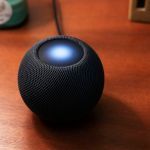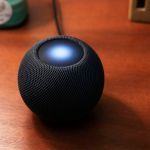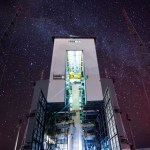Dominique Luchart's Blog, page 621
May 17, 2021
Apple HomePod and HomePod Mini can’t play lossless Apple Music, either, Sean Hollister

 Photo by Dan Seifert / The Verge
Photo by Dan Seifert / The VergeToday, we learned that Apple’s ultra-premium $550 AirPods Max headphones aren’t ready for the new lossless audio catalog coming to Apple Music next month — and they’re not alone. Apple confirms to The Verge that the HomePod and HomePod mini won’t support lossless audio, either. (MacRumors confirmed the same thing with sources earlier this afternoon.)
The good news is that the HomePod and HomePod mini will indeed support the company’s new spacial audio experiences, which are supposed to provide more immersive audio than a standard stereo or virtual surround mix — we were fairly intrigued trying spacial audio on the AirPods Pro, and it’s also coming to Apple Music next month in a bigger way.
And, Apple says, it’s not like any of these…
The post Apple HomePod and HomePod Mini can’t play lossless Apple Music, either, Sean Hollister appeared first on NEWDAWN Blog.
Apple HomePod and HomePod mini can’t play lossless Apple Music, either,

Today, we learned that Apple’s ultra-premium $550 AirPods Max headphones aren’t ready for the new lossless audio catalog coming to Apple Music next month — and they’re not alone. Apple confirms to The Verge that the HomePod and HomePod mini won’t support lossless audio, either. (MacRumors confirmed the same thing with sources earlier this afternoon.)
The good news is that the HomePod and HomePod mini will indeed support the company’s new spatial audio experiences, which are supposed to provide more immersive audio than a standard stereo or virtual surround mix — we were fairly intrigued trying spatial audio on the AirPods Pro, and it’s also coming to Apple Music next month in a bigger way.
And, Apple says, it’s not like any of these devices will fail to play back lossless tracks completely. They simply won’t be playing them at lossless quality.
Still, it seems like one more reason that Apple should really strongly consider having a fire sale for the original HomePod, which is somehow still available for a increasingly hard-to-justify $300 months after officially being discontinued.
The post Apple HomePod and HomePod mini can’t play lossless Apple Music, either, appeared first on NEWDAWN Blog.
Milky Way lights up Guiana spaceport in stunning timelapse video, ,

The Milky Way galaxy glistens over the launchsite of Europe’s new heavy-lift rocket in these stunning timelapse videos.
The European Space Agency (ESA) recently released a timelapse video capturing the pristine night sky above Europe’s spaceport in Kourou, French Guiana, where preparations are underway for the arrival and integration of Europe’s latest launcher, Ariane 6.
The first component of the rocket has already arrived at the Guiana Space Center: the payload fairing, a 18-foot-wide (5.4 meters), 66-foot-tall (20 m) nose cone that protects the payload during a launch. Engineers at the center are currently working to integrate the fairing with a mockup payload and ready it for a series of tests, according to an ESA statement.
However, most of the components of the rocket, which is scheduled for its debut flight in April 2022, have yet to undergo major tests in Europe.
On Tuesday (May 11) the manufacturer of Ariane 6, ArianeGroup (the parent company of Arianespace), announced that it had concluded testing of the central power unit of the rocket’s upper stage at its facilities in Vernon, France. The completion of the Auxiliary Power Unit’s (APU) qualification campaign paves the way for the first hot-fire test of the completed upper stage, which is currently being prepared at the facilities of the German Aerospace Centre (DLR) in Lampoldshausen.
The APU is one of the key components behind the Vinci reignitable engine that powers the upper stage. The power unit pressurizes the fuel tanks, which contain liquid hydrogen and liquid oxygen fuel, before each reignition in orbit. It can also provide additional thrust when needed and will be used to safely deorbit the upper stage after it delivers its cargo to space.
The reignitable Vinci engine will enable Ariane 6 to dispense batches of small satellites into various orbits, a key capability designed to cater to the needs of the growing small satellite and satellite megaconstellation market.
[image error]
(Image credit: ESA/CNES/Arianespace)Related: Meet Ariane 6 and Vega C: Europe’s new ‘rideshare’ rockets (videos)
“This propulsion system is a key factor in enhancing the versatility of Ariane 6, notably for launching constellations,” Andre-Hubert Roussel, CEO of ArianeGroup, said in a statement. “We took the decision of introducing this innovation during development, and the success of the qualification tests is a reward for the technological boldness shown by our Ottobrunn and Vernon teams who were able to invent and develop a multi-function instrument which makes a significant contribution to the competitiveness of Ariane 6.”
ArianeGroup, a joint venture between the European aerospace giant Airbus and French launcher manufacturer Safran, will produce Ariane 6 in two versions.
The lighter Ariane 62, with two strap-on boosters, will be able to lift about 9,920 lbs. (4,500 kilograms) into the geostationary orbit — an orbit at the altitude of 22,000 miles where satellites appear suspended above a certain spot on Earth — and up to 23,000 lbs. (10,300 kg) into low Earth orbit, the first 100-620 miles (160-1,000 km) of space.
The four-booster Ariane 64 will be able to lift 25,000 lbs. (11 500 kg) into geostationary orbit and 45,000 lbs. (20,600 kg) into low Earth orbit. For comparison, SpaceX’s Falcon Heavy rocket can loft up to 140,700 lbs. (63,820 kg) to low Earth orbit.
Ariane 6 was originally expected to perform its maiden flight in late 2020.
Follow Tereza Pultarova on Twitter @TerezaPultarova. Follow us on Twitter @Spacedotcom and on Facebook.
The post Milky Way lights up Guiana spaceport in stunning timelapse video, , appeared first on NEWDAWN Blog.
European startup builds oxygen-making machine for 2025 moon mission, ,

A European startup is perfecting technology that will be sent to the moon to make oxygen from lunar soil as part of a 2025 European Space Agency (ESA) demonstration mission.
Belgium-based Space Applications Services is building three experimental reactors under a contract with ESA announced on Wednesday (May 12). The reactors will be used to fine-tune the oxygen-making process to be tested on the moon as part of the planned in situ resource utilization demonstration (ISRU) mission in 2025.
The oxygen-making machine will rely on the FFC Cambridge process, originally developed in the late 1990s for direct extraction of titanium from titanium oxide, which can be found in nature in the minerals rutile and anatase. The process — named after its inventors George Chen, Derek Fray and Thomas Farthing, and Cambridge University in England where they all worked –uses electrolysis to separate the pure metal from the ore.
In the lunar environment, the technique will split lunar regolith, which is known to consist of up to 45% oxygen, into metal alloys and pure oxygen. The moon dirt in this process is used as a cathode, the electrode through which an electric current enters the electrolytic cell, releasing oxygen in the process.
While hauling oxygen supplies from Earth works just fine for short-duration space trips or missions that can be easily resupplied, locally made oxygen will be key for maintaining longer-term human presence on any celestial body, exploration advocates say. The metal alloys left after the oxygen extraction will not be wasted, either. In the future, they could be used to manufacture components for a moon base or a Martian station, for example with 3D printing.
Related: NASA’s Perseverance rover makes oxygen on Mars for 1st time
In addition to the FFC Cambridge method, Space Applications Services is also looking into another technique for oxygen extraction from lunar soil: the hydrogen reduction of ilmenite. Ilmenite is a titanium-rich ore found in some areas of the moon. The reduction technique involves baking the regolith in a closed container together with hydrogen gas. In the presence of heat, the oxygen from the ilmenite reacts with the hydrogen and forms water vapor, which can then be split into oxygen and hydrogen.
In addition to sustaining the crew, the oxygen and hydrogen manufactured on the moon could be used as fuel for missions venturing deeper into the solar system, for example to Mars.
Space Applications Services has recently completed an early design phase of the gear for the 2025 mission, which will for the first time demonstrate end-to-end production of both oxygen and water from local lunar resources, company representatives said in a statement.
ESA’s plan is to buy all services for the ISRU mission from commercial providers. That includes communication, transportation and services needed to operate the mission.
Follow Tereza Pultarova on Twitter @TerezaPultarova. Follow us on Twitter @Spacedotcom and on Facebook.
Join our Space Forums to keep talking space on the latest missions, night sky and more! And if you have a news tip, correction or comment, let us know at: community@space.com.
The post European startup builds oxygen-making machine for 2025 moon mission, , appeared first on NEWDAWN Blog.
That’s no moon: veteran Apple designer unveils $1,799 Cell Alpha speaker,

Christopher Stringer, an ex-Apple designer who worked on everything from the HomePod to the original iPhone during his 22 year-stint at the company, has unveiled his new startup’s debut speaker. It’s called the Cell Alpha, a futuristic Death Star-shaped connected speaker with an emphasis on spatial audio. It costs $1,799, or $1,969 if you want the model with a floorstanding base.
The Cell Alpha has woofers on its top and bottom arranged into a “force-balanced” configuration. These are paired with three mid-range drivers that are distributed around its equator, where they’re presumably joined by a small thermal exhaust port — the Cell Alpha’s only known weakness. Jokes aside, Stringer’s company Syng claims this three-driver configuration (dubbed “The Triphone”) is able to project sound with “pinpoint accuracy” around a room.
 Two of the floorstanding models.Image: Syng
Two of the floorstanding models.Image: SyngSyng is making big claims about the spatial audio capabilities of the Cell Alpha. It’s styling it as the world’s first “Triphonic” speaker, because it offers spatial audio capabilities beyond the stereo audio that’s long been the traditional standard. In practical terms it’s supposed to allow the speaker to fill an entire room with surround sound audio, creating the impression that specific sounds or instruments are coming from distinct areas of the room. There are three microphones built into the speaker’s stand to measure the geometry of the space it’s in, similar to the HomePod, which helps it create the impression of surround sound using just a single speaker.
 Even the model of the speaker with a table stand is hefty.Image: Syng
Even the model of the speaker with a table stand is hefty.Image: SyngWhile Syng says one speaker is capable of offering surround sound, anyone with $5,397 to spend can pair three Cell Alpha speakers together in a single room to get “the fullest expression of Triphonic audio.” According to a report from the Financial Times, Syng hopes to generate revenue from licensing out its audio technology in addition to selling hardware.
In terms of connectivity, Syng says the Cell Alpha supports AirPlay 2 and Spotify Connect over Wi-Fi. Physical connectivity is handled by a pair of USB-C ports, and Syng also says it’s planning on releasing a USB-C to HDMI cable to let the Cell Alpha connect to TVs (it can also output sound from a TV using AirPlay). A companion Syng Space app is available for setup and playback control.
 USB-C ports handle physical connectivity.Image: Syng
USB-C ports handle physical connectivity.Image: SyngSyng currently has around 50 employees according to Wired, and is reported to have raised $15 million in funding. The FT‘s report last year said these employees include ex-Apple designers and engineers, as well as former Nest, Ring, Nike, and Facebook employees. Others have reportedly joined from the audio companies Harman and Bowers & Wilkins.
The Cell Alpha is available to purchase now from Syng’s website. As of this writing, shipping is expected in six to eight weeks.
The post That’s no moon: veteran Apple designer unveils $1,799 Cell Alpha speaker, appeared first on NEWDAWN Blog.
Apple teases major Music announcement as lossless streaming rumors mount,
Apple is teasing a major Apple Music announcement. “Get ready,” a post in the service’s Browse tab reads, “music is about to change forever.” Tapping the image reveals an animated video, though it just consists of the music streaming service’s logo spinning in place. The teaser, first reported by MacRumors, is believed to refer to Apple Music’s rumored lossless and hi-res music streaming features.
A launch of the new higher quality streaming is believed to be imminent after code referencing “Lossless” and “Hi Res Lossless” streaming tiers appeared in the service’s Android and web apps. According to code in the Android app, the lossless tier will support music streaming at 24-bit/48Hz (a small step up from regular CD-quality 16-bit/44.1kHz), while the hi-res lossless tier will stream at 24-bit/192 kHz.
— MacRumors.com (@MacRumors)
Code in the Android app warns that these higher quality tiers will required more storage space and data to stream compared to existing quality. Apple Music’s current high quality tier consumes 6 MB of data for a 3-minute song, but this could rise to 36 MB with lossless, and 145 MB with hi-res lossless.
The benefit, of course, should be better sounding audio, similar to what’s already offered by the likes of Tidal, Amazon Music HD, and Deezer. Spotify has also announced its own lossless HiFi tier which is due to launch later this year.
As well as lossless and hi-res streaming, code snippets also include mentions of “Dolby Audio” and “Dolby Atmos,” 9to5Mac reports. The speculation is that the AirPods’ Spatial Audio features could be used in conjunction with Dolby’s surround sound technology.
Apple’s teaser doesn’t say when we should expect an official announcement, but some rumors suggest an announcement as early as Tuesday.
The post Apple teases major Music announcement as lossless streaming rumors mount, appeared first on NEWDAWN Blog.
Apple teases major Music announcement as lossless streaming rumors mount, Jon Porter

 A screenshot of the teaser in Apple Music’s web app. | Screenshot: Apple Music
A screenshot of the teaser in Apple Music’s web app. | Screenshot: Apple MusicApple is teasing a major Apple Music announcement. “Get ready,” a post in the service’s Browse tab reads, “music is about to change forever.” Tapping the image reveals an animated video, though it just consists of the music streaming service’s logo spinning in place. The teaser, first reported by MacRumors, is believed to refer to Apple Music’s rumored lossless and hi-res music streaming features.
A launch of the new higher quality streaming is believed to be imminent after code referencing “Lossless” and “Hi Res Lossless” streaming tiers appeared in the service’s Android and web apps. According to code in the Android app, the lossless tier will support music streaming at 24-bit/48Hz (a small step up from regular CD-quality…
The post Apple teases major Music announcement as lossless streaming rumors mount, Jon Porter appeared first on NEWDAWN Blog.
Sharp’s new flagship phone has a giant 1-inch camera sensor and Leica branding,

It appears that Leica has found a new mobile camera partner, following Huawei’s sanctions-induced retreat from the international smartphone market. Sharp just announced the Aquos R6 in Japan, and its Leica-branded lens sits in front of what is now the largest camera sensor on any phone.
The 20-megapixel 1-inch sensor is similar in specs to what you’d find in Sony’s high-end RX100 compact cameras. It’s only the second 1-inch sensor ever to make its way into a smartphone, and the first to make its way into a phone from an traditional phone manufacturer — Panasonic released the Android-powered CM1 back in 2014, but it wasn’t exactly a mainstream device. The closest any current phone gets to a 1-inch sensor is Xiaomi’s new Mi 11 Ultra, which has a 1/1.12-inch component behind the lens.
The f/1.9 “Summicron” lens is also much wider than on other phones’ primary cameras, with an equivalent focal length of 19mm — that’s in ultrawide territory. Oddly, it’s the only outward-facing camera on the R6, so you’ll need to use digital zoom for more conventional focal lengths. The camera bump also houses an LED flash and a time-of-flight sensor.
The Aquos R6’s other big feature is its display, which Sharp calls a Pro IGZO OLED. It’s a 6.6-inch 2,730 x 1,260 panel with a peak brightness of 2,000 nits and a variable refresh rate of 1 to 240Hz. Most Android phones to date haven’t been able to offer OLED displays with truly variable refresh rates that adapt to content in real time — this panel sounds like the most advanced available on any phone right now.
Elsewhere the R6’s specs are standard for a 2021 flagship: a Snapdragon 888, 12GB of RAM, 128GB of storage, and a 5,000mAh battery. It’ll go on sale in June in Japan through carriers NTT Docomo and SoftBank. Pricing isn’t yet available.
The post Sharp’s new flagship phone has a giant 1-inch camera sensor and Leica branding, appeared first on NEWDAWN Blog.
Sharp’s new flagship phone has a giant 1-inch camera sensor and Leica branding, Sam Byford


It appears that Leica has found a new mobile camera partner, following Huawei’s sanctions-induced retreat from the international smartphone market. Sharp just announced the Aquos R6 in Japan, and its Leica-branded lens sits in front of what is now the largest camera sensor on any phone.
The 20-megapixel 1-inch sensor is similar in specs to what you’d find in Sony’s high-end RX100 compact cameras. It’s only the second 1-inch sensor ever to make its way into a smartphone, and the first to make its way into a phone from an traditional phone manufacturer — Panasonic released the Android-powered CM1 back in 2014, but it wasn’t exactly a mainstream device. The closest any current phone gets to a 1-inch sensor is Xiaomi’s new Mi 11 Ultra, which…
The post Sharp’s new flagship phone has a giant 1-inch camera sensor and Leica branding, Sam Byford appeared first on NEWDAWN Blog.
May 16, 2021
Final Fantasy director’s Paralympics RPG is launching next month, Sam Byford


The first project from Final Fantasy XV director Hajime Tabata’s new studio JP Games will finally be released next month, the company has announced. The Pegasus Dream Tour is a mobile RPG themed around the Paralympic Games, the first game ever to carry the official Paralympics license. It was initially announced more than two years ago, but the Tokyo Olympics and Paralympics were postponed a year due to the COVID-19 pandemic, and there’d been radio silence on the project ever since.
JP Games describes The Pegasus Dream Tour as an “avatar RPG” set in Pegasus City. You can create a character based on a selfie from your phone, and train them in various para-sports. The game features illustrated versions of nine real-world para-athletes who…
The post Final Fantasy director’s Paralympics RPG is launching next month, Sam Byford appeared first on NEWDAWN Blog.



